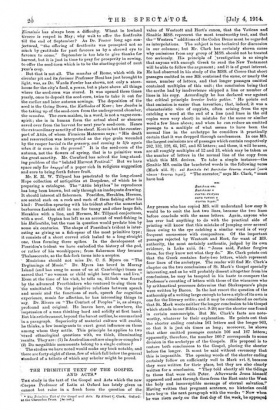THE PRIMITIVE TEXT OF THE GOSPEL AND ACTS.* ,THE study
in the text of the Gospel and Acts which the new oCerpus Professor of Latin at Oxford has lately given us cannot but raise in a fresh form the question of the
4 .6 The Primitive rat of the Goipel end Acts. By Albert C. Clark, Oxford ; at the Clarentloli Preee. [4e. nat.j
value of Westcott and Hort's canon, that the Vatican and Sinaitic MSS. represent the most trustworthy text, and that the " Western " additions of the Codex Bezae must be regarded as interpolations. The subject is too technical for discussion in our columns ; but Mr. Clark has certainly shown cause
why omissions from any group of MSS. should not be treated too seriously. His principle of :Ivestigation is so simple that anyone with enough Greek to read the New Testament will be able to follow the argument ; and it is of great interest. He had observed in his study of the MSS. of Cicero that abort passages omitted in one MS. contained the same, or nearly the same, number of letters, and that longer passages omitted contained multiples of this unit ; the conclusion being that the scribe had by inadvertence skipped a line or number of lines in his copy. Accordingly he has declared war against the critical principle bretrior lectio potion He points out that omission is easier than invention ; that, indeed, it was a characteristic vice of copyists, often arising from the eye catching a word at the end of a line (and lines in the old copies were very short) in mistake for the same or similar word a few lines above; and when he can reduce an omitted passage to a multiple of what seems to have been the normal line in the archetype he considers it practically certain that it was dropped through carelessness. In one MS. the largest omissions are of passages which contain respectively 262, 132, 128, 65, 167, and 83 letters; and these, it will be seen, are all roughly multiples of 12 and 13, which may be taken as the number of letters in the normal line of the copy from which this MS. derives. To take a simple instance—the Sinaitic MS. omits the bracketed words in the following verse (Mark xiii. 8): rah flairtketa Jiri Bauuldav girorrat o-fargol 7.111rous • kaorrai At}soa. "The ancestor," says Mr. Clark, "must have had
sat
'Meat Fla errs iiiao-sAetar e crovrat cregoitos stwra TOWOUS f crorrat Xtgot." V.
Any person who has copied MS. will understand how easy it would be to omit the last two lines, because the two lines before conclude with the same letters. Again, anyone who has ever had anything to do with the practical side of printing will know that this mistake of jumping over several lines owing to the eye catching a similar word is of very frequent occurrence with compositors. Of the important passages rejected by Westcott and Hort, for want of MS.
authority, the most certainly authentic, judged by its own evidence, is Luke xxiii. 34: "Jesus said, Father forgive them, for they know not what they do." Mr. Clark points out that the Greek contains forty-two letters, which represent four lines of the archetype. The reader will find Mr. Clark's chapter on the two conclusions of St. Mark's Gospel specially interesting, and as he will probably dissent altogether from his conclusions, he may be tempted in his haste to compare the Professor's counting of letters with those of the wiseacres who
by arithmetical processes determine that Shakespeare's plays were written by Bacon. In the last resort the question of the authorship of a writing large enough to have a style of its own is one for the literary critic ; and it may be considered as certain that St. Mark wrote neither the longer conclusion to his Gospel which stands in our Bibles (xvi. 9-20) nor the shorter one found in certain manuscripts. But Mr. Clark's facts are note- worthy, whatever be their explanation. He points out that the shorter ending contains 161 letters and the longer 963, so that it is just six times as long; moreover, he shows that other omitted passages contain 166 and 167 lettere; apparently, therefore, the number 160-7 corresponds to some division in the archetype of the Gospels. His proposal is to restore both conclusions to the Gospel, placing the shorter before the longer. It must be said without ceremony that this is impossible. The opening words of the shorter ending certainly follow on sufficiently well to Mark xvi. 8, because they were written for their place, but they are also clearly written for a conclusion. "They told shortly all the tidings to those that were with Peter. Afterwards Jesus himself appeared and sent through them from the East unto' the West the holy and incorriiptible meseage of eternal salvation! Having written that pregnant sentence, no historian could have beg-in the next paragraph with the words: "Now when he was risen .early.mr the first day of the..week, he appeare4
first to Mary Magdalene"; and the intercalation of the "shorter ending" between verses 8 and 9 does not make, any more possible the description of Mary Magdalene as one "out of whom he had cast seven devils," considering that she has been the principal subject of the story in the earlier part of the chapter.



















































 Previous page
Previous page